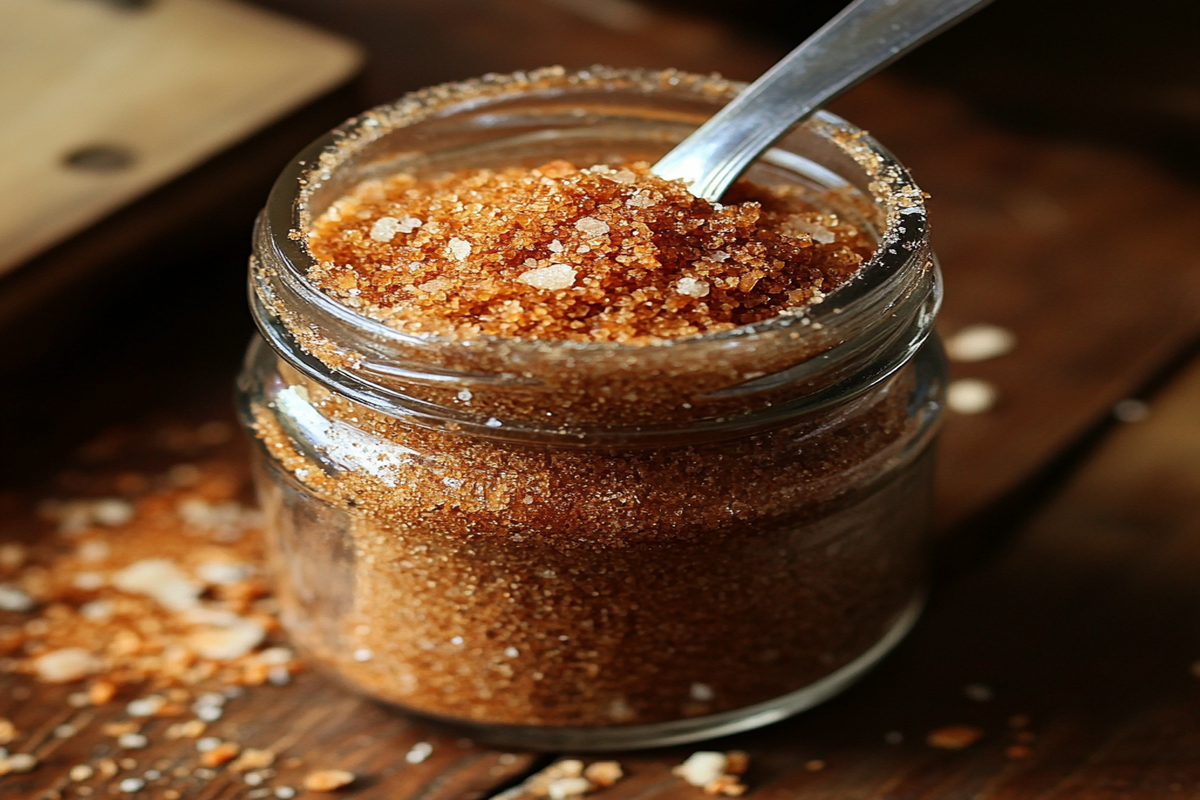What Is a BBQ Rub?
A demarara sugar BBQ rub recipe is a blend of spices, sugar, and herbs designed to enhance the flavor of grilled or smoked food. Unlike marinades, which penetrate the meat, a rub creates a flavorful crust when cooked. This crust locks in juices, delivering that smoky, caramelized texture we all love.
For anyone passionate about grilling, having a go-to rub is essential. Among various sugar types used in rubs, Demerara sugar stands out for its unique characteristics, offering depth and complexity to barbecue flavors.
Why Use Demerara Sugar in a BBQ Rub?
Demerara sugar, known for its coarse texture and molasses-rich flavor, excels in BBQ rubs because:
- Its large crystals melt slowly, allowing for even caramelization.
- It imparts a deep, earthy sweetness that pairs well with smoky and spicy notes.
- The sugar’s natural molasses complements other rub ingredients, enhancing their complexity.
Unlike refined white sugar, which tends to burn quickly, Demerara sugar provides stability at higher temperatures, making it ideal for grilling.
Ingredients Overvie
Core Ingredients of a BBQ Rub
A typical demarara sugar BBQ rub recipe consists of:
- Sugar: Provides sweetness and balances the heat.
- Salt: Enhances flavor and helps tenderize meat.
- Spices: Common additions include paprika, black pepper, and garlic powder.
- Herbs: Dried oregano or thyme adds herbal notes.
The Role of Demerara Sugar
Demerara sugar shines in this blend by adding:
- A unique crunch to the rub.
- A rich flavor profile that enhances both meat and vegetables.
- A beautiful caramelized glaze when exposed to heat.
Complementary Spices for Balance
Pairing Demerara sugar with the following spices ensures a balanced rub:
- Paprika: Adds smokiness.
- Cumin: Brings earthiness.
- Chili Powder: Introduces heat for a bold finish.
Selecting Demerara Sugar
What Makes Demerara Sugar Unique?
Unlike brown or refined sugar, Demerara sugar has a coarser texture and retains more molasses. This gives it:
- A natural, unprocessed edge.
- A robust flavor, ideal for BBQ applications.
Alternatives to Demerara Sugar
While Demerara is preferred, substitutes like turbinado sugar or light brown sugar can work in a pinch. However, they lack the signature crunch and depth of flavor Demerara provides.
Where to Buy Quality Demerara Sugar
You can find high-quality Demerara sugar:
- At specialty grocery stores.
- Through online retailers offering bulk options.
- In organic or natural food aisles.
The Science of Flavor
How Sugar Enhances BBQ Flavors
Sugar does more than sweeten—it reacts with heat to create Maillard browning, forming a flavorful crust. This reaction, combined with the smokiness of the grill, creates the complex taste barbecue is famous for.
Caramelization and Browning in BBQ
Demerara sugar’s coarse crystals dissolve gradually, allowing:
- Even caramelization.
- A balanced glaze that’s neither too sticky nor burnt.
Balancing Sweetness with Heat
Adding chili powder or cayenne balances Demerara sugar’s sweetness, ensuring the rub doesn’t overpower the meat. The combination of sweet and spicy is key to creating a versatile rub that works on multiple proteins.
Equipment Needed
Tools for Mixing and Storing BBQ Rubs
- Mixing Bowls: For even blending.
- Airtight Jars: Keeps the rub fresh and moisture-free.
- Measuring Spoons: Ensures consistent ratios.
Storage Tips to Keep Rubs Fresh
- Store in a cool, dry place.
- Use desiccant packets to prevent clumping.
- Label jars with the date to track freshness.
Essential Utensils for Applying the Rub
- A basting brush ensures even application.
- Rub gloves help distribute spices evenly without mess.
- Shakers make sprinkling rubs on large cuts easier.
Base Recipe for Demerara Sugar BBQ Rub
Step-by-Step Instructions for Making the Rub
Here’s a simple yet flavorful Demerara sugar BBQ rub recipe that works wonders on meats, seafood, and vegetables:
Ingredients:
- ½ cup Demerara sugar
- ¼ cup paprika
- 2 tablespoons kosher salt
- 1 tablespoon black pepper
- 1 tablespoon chili powder
- 1 teaspoon garlic powder
- 1 teaspoon onion powder
- 1 teaspoon cumin
- ½ teaspoon cayenne pepper (optional for heat)
Instructions:
- Measure Ingredients: Use measuring spoons and cups to ensure precise ratios.
- Combine in a Bowl: Mix all ingredients thoroughly, ensuring the sugar and spices are evenly distributed.
- Store Properly: Transfer the blend to an airtight jar and label it with the date.
This rub can be stored for up to six months in a cool, dry place, retaining its vibrant flavors.
Adjusting Ratios for Personalized Flavors
- For a sweeter rub, increase the Demerara sugar to ¾ cup.
- Prefer a smoky profile? Add an extra tablespoon of smoked paprika.
- If you enjoy heat, double the cayenne or chili powder.
Tips for Achieving the Perfect Texture
- Use a mortar and pestle to break down any clumps in spices or sugar.
- Sift the mix if you prefer a smoother texture for easier application.
Variations on the Recipe
Sweet and Spicy Demerara Sugar Rub
This version amplifies the heat while maintaining a sweet base:
- Increase cayenne to 1 teaspoon.
- Add a pinch of ground cinnamon for a warm, aromatic note.
Smoky BBQ Rub with Demerara Sugar
Perfect for brisket or pork:
- Replace regular paprika with smoked paprika.
- Add 1 teaspoon of ground chipotle for a deeper smoky flavor.
Citrus-Infused Demerara Sugar Rub
For a fresh and zesty twist:
- Add 1 teaspoon of dried lemon or orange zest.
- Include ½ teaspoon of ground coriander for a citrusy undertone.
How to Use BBQ Rubs
Best Meats and Vegetables to Pair with Demerara Sugar BBQ Rub
- Meats: Works best on ribs, chicken wings, brisket, pork shoulder, and salmon.
- Vegetables: Enhances the sweetness of grilled corn, sweet potatoes, and bell peppers.
Techniques for Applying the Rub
- Dry Application: Pat the meat dry and generously coat it with the rub, pressing it in for even coverage.
- Wet Application: Mix the rub with a bit of oil or mustard to create a paste, then spread it evenly on the meat.
Marination vs. Dry Rub Application
- Marination: Combine the rub with a liquid (like apple juice or vinegar) for deeper penetration.
- Dry Rub: Ideal for forming a crust during cooking, locking in moisture and flavor.
Storing and Preserving BBQ Rub
Proper Storage Conditions
- Store the rub in an airtight container.
- Avoid direct sunlight to preserve the spices’ vibrancy.
Shelf Life of Homemade BBQ Rub
- Most rubs, when stored properly, remain fresh for 3 to 6 months.
- Check periodically for clumping or loss of aroma, which indicates it’s time to make a new batch.
Signs of Spoilage
- Mold or moisture buildup.
- Dull or faded colors.
- Loss of the signature spicy-sweet aroma.
Common Mistakes to Avoid
Overpowering with Sugar
While Demerara sugar is a key ingredient, using too much can result in:
- A burnt taste due to over-caramelization.
- A rub that is overly sweet and unbalanced.
Misbalancing Flavors
- Ensure the ratio of sweet, salty, and spicy ingredients is harmonious.
- Avoid using only strong spices like cayenne without balancing them with herbs or mild flavors.
Incorrect Storage Practices
- Do not store rubs in humid environments as moisture can degrade their quality.
- Always seal containers tightly after each use.
Customizing BBQ Rubs
Adjusting Heat Levels
Tailoring the spice level of your rub is simple and highly customizable:
- For Mild Heat: Use only ½ teaspoon of chili powder and omit cayenne.
- For Medium Heat: Stick to the standard recipe proportions.
- For High Heat: Double the cayenne pepper or add crushed red pepper flakes.
You can also experiment with exotic chili powders like ancho, guajillo, or habanero for unique heat profiles.
Incorporating Exotic Spices
Adding unconventional spices enhances the rub’s flavor complexity:
- Sumac: Adds a tart, citrusy note that complements smoky meats.
- Allspice: Offers warm, nutty undertones for Caribbean-inspired dishes.
- Chinese Five Spice: Combines sweet and savory elements, ideal for pork ribs.
Making the Rub Gluten-Free or Vegan
Most BBQ rubs are inherently gluten-free and vegan, but you should:
- Ensure no cross-contamination of spices with wheat-based ingredients.
- Double-check that all spices and Demerara sugar are processed in gluten-free facilities.
Using the BBQ Rub for Smoking
Ideal Smoking Temperatures
Smoking requires maintaining a steady temperature to let the rub create its signature crust without burning:
- Low and Slow: 225°F–250°F for tender meats like brisket or pork shoulder.
- Moderate Heat: 300°F for quicker cooks like chicken thighs or ribs.
Achieving a Smoky Crust with Demerara Sugar
The coarse texture of Demerara sugar plays a critical role:
- It melts gradually, fusing with spices to form a thick crust.
- Its molasses content ensures a rich, caramelized finish.
To maximize this effect, allow the rub to sit on the meat for at least 1–2 hours before smoking.
Maintaining Juicy and Tender Meat
- Use a spray bottle with apple juice or vinegar to keep the meat moist during long smoking sessions.
- Wrap meat in foil during the final stages of cooking to lock in juices while allowing the rub to set.
BBQ Rub Pairings
Perfect Side Dishes for Demerara Sugar BBQ Rub
Pair your BBQ dishes with sides that complement the sweet and smoky flavors:
- Classic Options: Coleslaw, baked beans, or cornbread.
- Fresh Choices: Grilled asparagus or a summer salad with citrus vinaigrette.
- Sweet Finishes: Grilled peaches or pineapple for a tropical flair.
Best Sauces to Complement the Rub
Elevate your BBQ dishes by pairing the rub with complementary sauces:
- Sweet BBQ Sauce: Reinforces the Demerara sugar’s sweetness.
- Spicy Chipotle Sauce: Adds a smoky, peppery kick.
- Mustard-Based Sauce: Cuts through sweetness with tangy boldness.
Beverage Pairings for BBQ
Drinks play a vital role in enhancing the dining experience:
- Beer: A hoppy IPA balances the sweetness, while a dark stout complements the molasses flavors.
- Wine: A bold Zinfandel or fruity Syrah works well with smoky BBQ.
- Mocktails: Lemonade or a ginger-lime spritzer provides a refreshing contrast.
FAQs About BBQ Rubs
- How Long Should the Rub Sit on the Meat? Let the rub sit for at least 1–2 hours. For deeper flavor, refrigerate overnight.
- Can You Use BBQ Rub on Grilled Vegetables? Absolutely! Rub works beautifully on sweet potatoes, zucchini, and even corn.
- What Meat Cuts Work Best with This Rub? This rub is versatile, but it’s particularly excellent on ribs, pork shoulder, and chicken thighs.
- Can I Add Liquid to the Rub? Yes, combining it with olive oil or mustard forms a paste for wet applications.
- How Do I Prevent the Rub from Burning? Keep the grill temperature low and avoid direct flames. The Demerara sugar’s slow melt helps mitigate burning.
- Is It Okay to Use Demerara Sugar Rub for Frying? It’s not ideal since high frying temperatures can cause the sugar to burn quickly.
- How Much Rub Should I Use? Use about 1 tablespoon per pound of meat, adjusting based on personal taste.
- Can I Use the Rub on Fish? Yes! It’s especially tasty on salmon and tilapia.
- How Do I Refresh an Old Rub? Add fresh spices and blend thoroughly to restore its flavor.
- Can I Freeze the Rub? Freezing isn’t necessary, but you can store it in an airtight container in the freezer to extend shelf life.
The History of BBQ Rubs
Evolution of BBQ Rubs
BBQ rubs have a rich history rooted in regional culinary traditions:
- Southern BBQ: Known for sweet and smoky rubs featuring brown sugar and paprika.
- Texas BBQ: Minimalist, focusing on salt, pepper, and a hint of spice.
- Caribbean Influence: Incorporates warm spices like allspice and nutmeg.
The Role of Sugar in Traditional BBQ Rubs
Sugar has always been a staple in BBQ rubs due to its ability to:
- Balance smoky and spicy flavors.
- Enhance caramelization, creating a distinct BBQ texture.

